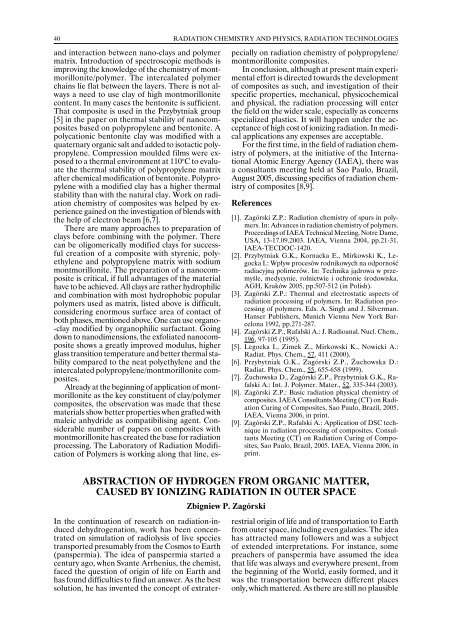annual report annual report annual report annual report 2005
annual report annual report annual report annual report 2005
annual report annual report annual report annual report 2005
Create successful ePaper yourself
Turn your PDF publications into a flip-book with our unique Google optimized e-Paper software.
40<br />
RADIATION CHEMISTRY AND PHYSICS, RADIATION TECHNOLOGIES<br />
pecially on radiation chemistry of polypropylene/<br />
montmorillonite composites.<br />
In conclusion, although at present main experimental<br />
effort is directed towards the development<br />
of composites as such, and investigation of their<br />
specific properties, mechanical, physicochemical<br />
and physical, the radiation processing will enter<br />
the field on the wider scale, especially as concerns<br />
specialized plastics. It will happen under the acceptance<br />
of high cost of ionizing radiation. In medical<br />
applications any expenses are acceptable.<br />
For the first time, in the field of radiation chemistry<br />
of polymers, at the initiative of the International<br />
Atomic Energy Agency (IAEA), there was<br />
a consultants meeting held at Sao Paulo, Brazil,<br />
August <strong>2005</strong>, discussing specifics of radiation chemistry<br />
of composites [8,9].<br />
References<br />
[1]. Zagórski Z.P.: Radiation chemistry of spurs in polymers.<br />
In: Advances in radiation chemistry of polymers.<br />
Proceedings of IAEA Technical Meeting, Notre Dame,<br />
USA, 13-17.09.2003. IAEA, Vienna 2004, pp.21-31.<br />
IAEA-TECDOC-1420.<br />
[2]. Przybytniak G.K., Kornacka E., Mirkowski K., Legocka<br />
I.: Wpływ procesów rodnikowych na odporność<br />
radiacyjną polimerów. In: Technika jądrowa w przemyśle,<br />
medycynie, rolnictwie i ochronie środowiska.<br />
AGH, Kraków <strong>2005</strong>, pp.507-512 (in Polish).<br />
[3]. Zagórski Z.P.: Thermal and electrostatic aspects of<br />
radiation processing of polymers. In: Radiation processing<br />
of polymers. Eds. A. Singh and J. Silverman.<br />
Hanser Publishers, Munich Vienna New York Barcelona<br />
1992, pp.271-287.<br />
[4]. Zagórski Z.P., Rafalski A.: J. Radioanal. Nucl. Chem.,<br />
196, 97-105 (1995).<br />
[5]. Legocka I., Zimek Z., Mirkowski K., Nowicki A.:<br />
Radiat. Phys. Chem., 57, 411 (2000).<br />
[6]. Przybytniak G.K., Zagórski Z.P., Żuchowska D.:<br />
Radiat. Phys. Chem., 55, 655-658 (1999).<br />
[7]. Żuchowska D., Zagórski Z.P., Przybytniak G.K., Rafalski<br />
A.: Int. J. Polymer. Mater., 52, 335-344 (2003).<br />
[8]. Zagórski Z.P.: Basic radiation physical chemistry of<br />
composites. IAEA Consultants Meeting (CT) on Radiation<br />
Curing of Composites, Sao Paulo, Brazil, <strong>2005</strong>.<br />
IAEA, Vienna 2006, in print.<br />
[9]. Zagórski Z.P., Rafalski A.: Application of DSC technique<br />
in radiation processing of composites. Consultants<br />
Meeting (CT) on Radiation Curing of Composites,<br />
Sao Paulo, Brazil, <strong>2005</strong>. IAEA, Vienna 2006, in<br />
print.<br />
ABSTRACTION OF HYDROGEN FROM ORGANIC MATTER,<br />
CAUSED BY IONIZING RADIATION IN OUTER SPACE<br />
Zbigniew P. Zagórski<br />
In the continuation of research on radiation-induced<br />
dehydrogenation, work has been concentrated<br />
on simulation of radiolysis of live species<br />
transported presumably from the Cosmos to Earth<br />
(panspermia). The idea of panspermia started a<br />
century ago, when Svante Arrhenius, the chemist,<br />
faced the question of origin of life on Earth and<br />
has found difficulties to find an answer. As the best<br />
solution, he has invented the concept of extrater-<br />
and interaction between nano-clays and polymer<br />
matrix. Introduction of spectroscopic methods is<br />
improving the knowledge of the chemistry of montmorillonite/polymer.<br />
The intercalated polymer<br />
chains lie flat between the layers. There is not always<br />
a need to use clay of high montmorillonite<br />
content. In many cases the bentonite is sufficient.<br />
That composite is used in the Przybytniak group<br />
[5] in the paper on thermal stability of nanocomposites<br />
based on polypropylene and bentonite. A<br />
polycationic bentonite clay was modified with a<br />
quaternary organic salt and added to isotactic polypropylene.<br />
Compression moulded films were exposed<br />
to a thermal environment at 110 o C to evaluate<br />
the thermal stability of polypropylene matrix<br />
after chemical modification of bentonite. Polypropylene<br />
with a modified clay has a higher thermal<br />
stability than with the natural clay. Work on radiation<br />
chemistry of composites was helped by experience<br />
gained on the investigation of blends with<br />
the help of electron beam [6,7].<br />
There are many approaches to preparation of<br />
clays before combining with the polymer. There<br />
can be oligomerically modified clays for successful<br />
creation of a composite with styrenic, polyethylene<br />
and polypropylene matrix with sodium<br />
montmorillonite. The preparation of a nanocomposite<br />
is critical, if full advantages of the material<br />
have to be achieved. All clays are rather hydrophilic<br />
and combination with most hydrophobic popular<br />
polymers used as matrix, listed above is difficult,<br />
considering enormous surface area of contact of<br />
both phases, mentioned above. One can use organo-<br />
-clay modified by organophilic surfactant. Going<br />
down to nanodimensions, the exfoliated nanocomposite<br />
shows a greatly improved modulus, higher<br />
glass transition temperature and better thermal stability<br />
compared to the neat polyethylene and the<br />
intercalated polypropylene/montmorillonite composites.<br />
Already at the beginning of application of montmorillonite<br />
as the key constituent of clay/polymer<br />
composites, the observation was made that these<br />
materials show better properties when grafted with<br />
maleic anhydride as compatibilising agent. Considerable<br />
number of papers on composites with<br />
montmorillonite has created the base for radiation<br />
processing. The Laboratory of Radiation Modification<br />
of Polymers is working along that line, esrestrial<br />
origin of life and of transportation to Earth<br />
from outer space, including even galaxies. The idea<br />
has attracted many followers and was a subject<br />
of extended interpretations. For instance, some<br />
preachers of panspermia have assumed the idea<br />
that life was always and everywhere present, from<br />
the beginning of the World, easily formed, and it<br />
was the transportation between different places<br />
only, which mattered. As there are still no plausible
















